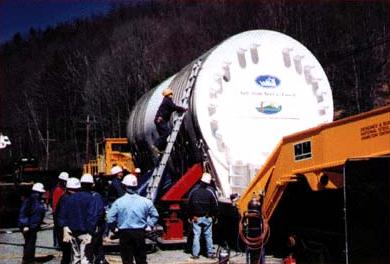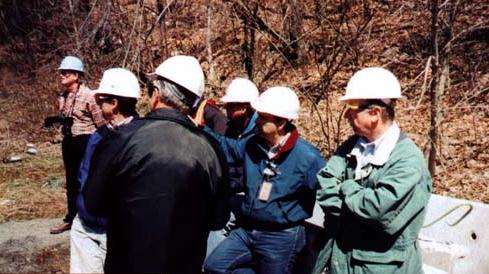
Energy in Motion
By shipping a reactor vessel for the Yankee Atomic Electric Company, Guilford Rail System took part in yet another step in the process to dismantle the Yankee Rowe plant and restore the site to a green field.
The vessel package took a six hour truck ride to the Hoosac Tunnel in Florida, Massachusetts where it was loaded onto a 140 foot, 18-axle rail car. From there the vessel was transported by Guilford Rail System to its Mohawk Yard. There it was interchanged to the CP/D&H and continued by rail to a low-level waste disposal facility in Barnwell, South Carolina.
The amount of preparation involved with such a move can at first glance appear to be overwhelming. However, thr railroad was well prepared to undertake the project as a result of its successful movement, in November of 1993, of two 150 ton steam generators from the Yankee Rowe plant. Once again, all departments in the Guilford Rail System worked together to make this move go safely and smoothy.
A preliminary review of the shipment route revealed that the 45 bridges on the line would be loaded to their limits. This shipment exceeded any previous heavy weight movement over Guilford’s rail lines. The nuclear shipment weighed 1,122,000 lbs.
The container, with the vessel and 60 tons of concrete inside, and its lid welded in place, weighs approximately 335 tons, is 28 feet long and 13 feet in diameter. The reactor vessel, which once held the fuel used to generate electricity, is approximately 27 feet long and 12 feet at its widest point. The container is made of carbon steel with 8-inch thick walls. In order to distribute this load and move it safely, the package was shipped on an 18-axle rail car with two spacer cars placed between it and the engine to disperse the immense weight.

The Engineering and Bridge & Building Departments performed a complete structural analysis and inspection of the bridges. West End Bridge & Building Supervisor David Carey, along with Bridge Inspector Tom Fifield and others spent the better part of six weeks in the field, and helped produce a bridge study that supplied Guilford Rail with all the data and backup information needed to safely cross our line.
The analysis also revealed that the shipment would stress several structures to 97% of their maximum allowable capacity. To reduce the load on one bridge in Schaghticoke, New York, over 3000 feet of track were moved laterally up to six feet.
To help “lighten the load” Guilford Rail’s Matt Raylinsky, General Superintendent of Cars, Mechanical Department, traveled to Transalta Power Corporation in Calgary, Canada to evaluate a special heavy-duty flat car. Jim Austin, General Manager of Car Maintenance and Dave Dunn, Manager of Car Maintenance, East Deerfield, worked closely with Raylinsky in choosing and inspecting the rail car. The car is equipped with 18 axles and can transport a weight in excess of one million pounds. The flat car can laterally shift a load up to 14 inches off center to the right or left and raise or lower the car body up to 12 inches. The extra axles and load shifting capabilities of the Transalta car distributed the load, thereby enabling it to be safely moved over the lines and bridges of five different railroads on its way to South Carolina.
Keeping the lines of communication open was Guilford Rail’s Steve Giguere, who upgraded phone lines to the loading site to handle fax capabilities. Giguere was also instrumental in maintaining clear communications while the train was passing through the 4.9-mile Hoosac Tunnel.
Finally, to ensure a safe trip, a track crew hi-railed in front of the train and Railroad Police provided security along the route.
Springfield Terminal’s Project Engineer Jeff Rose (center) discusses the transfer of the reactor vessel with Yankee Atomic’s Leo Lessard (left, blue jacket) and Guilford’s Safety Representative Bob Degroot (right).



